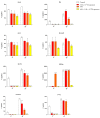In Vitro Cytotoxic Protective Effect of Alginate-Encapsulated Capsaicin Might Improve Skin Side Effects Associated with the Topical Application of Capsaicin
- PMID: 33800110
- PMCID: PMC7962180
- DOI: 10.3390/molecules26051455
In Vitro Cytotoxic Protective Effect of Alginate-Encapsulated Capsaicin Might Improve Skin Side Effects Associated with the Topical Application of Capsaicin
Abstract
Chronic neuropathic pain, particularly peripheral pain, is a cause of great concern for diabetic patients. Current treatments include numerous agents such as capsaicinoids, a known deterrent of neuropathic pain despite the inconvenience associated with local side effects. In this context, the current work aims to elucidate the potential mechanisms involved in cytotoxicity by capsaicin and proposes an efficient formulation of capsaicin in alginate microcapsules, which significantly reduces side effects from capsaicin topical administration. For this, human dermal fibroblast cells were treated with alginate-microencapsulated capsaicin extracts and screened for potential cytotoxic effects produced by the treatment. Cell viability and morphology were examined, as well as oxidative stress status and anti-inflammatory potential. Our results show that the alginate encapsulated formulation of capsaicin exerted lower cytotoxic effects on human dermal fibroblasts as measured by cell viability and reactive oxygen species (ROS) production. Furthermore, the expression profiles of inflammatory cytokines were significantly altered by the treatment as compared with the control culture.
Keywords: alginate encapsulation; capsaicin; cytotoxicity; inflammation; neuropathic pain.
Conflict of interest statement
The authors declare no conflict of interest. The funders had no role in the design of the study; in the collection, analyses, or interpretation of data; in the writing of the manuscript, or in the decision to publish the results.
Figures









Similar articles
-
Capsaicin-loaded nanolipoidal carriers for topical application: design, characterization, and in vitro/in vivo evaluation.Int J Nanomedicine. 2017 May 22;12:3881-3898. doi: 10.2147/IJN.S131901. eCollection 2017. Int J Nanomedicine. 2017. PMID: 28579775 Free PMC article.
-
Effect of topical application of capsaicin and its related compounds on dermal insulin-like growth factor-I levels in mice and on facial skin elasticity in humans.Growth Horm IGF Res. 2007 Apr;17(2):171-6. doi: 10.1016/j.ghir.2006.12.005. Epub 2007 Feb 20. Growth Horm IGF Res. 2007. PMID: 17307377
-
Alginate encapsulation of genetically engineered mammalian cells: comparison of production devices, methods and microcapsule characteristics.J Microencapsul. 2003 May-Jun;20(3):303-16. doi: 10.1080/0265204021000058438. J Microencapsul. 2003. PMID: 12881112
-
Topical therapies in the management of chronic pain.Postgrad Med. 2013 Jul;125(4 Suppl 1):25-33. doi: 10.1080/00325481.2013.1110567111. Postgrad Med. 2013. PMID: 24547601 Review.
-
Capsaicinoids in the treatment of neuropathic pain: a review.Ther Adv Neurol Disord. 2014 Jan;7(1):22-32. doi: 10.1177/1756285613501576. Ther Adv Neurol Disord. 2014. PMID: 24409200 Free PMC article. Review.
Cited by
-
Effect of Chemical Degradation of Sodium Alginate on Capsaicin Encapsulation.Molecules. 2023 Nov 29;28(23):7844. doi: 10.3390/molecules28237844. Molecules. 2023. PMID: 38067573 Free PMC article.
-
Capsaicin: Emerging Pharmacological and Therapeutic Insights.Curr Issues Mol Biol. 2024 Jul 24;46(8):7895-7943. doi: 10.3390/cimb46080468. Curr Issues Mol Biol. 2024. PMID: 39194685 Free PMC article. Review.
-
Encapsulation of Capsaicin in Oil-In-Water Nanoemulsion: Optimization by a Mixture Design and Its Application in Merguez Sausage Preservation.Food Sci Nutr. 2025 Feb 23;13(2):e70042. doi: 10.1002/fsn3.70042. eCollection 2025 Feb. Food Sci Nutr. 2025. PMID: 39995974 Free PMC article.
-
One-Step Encapsulation of Capsaicin into Chitosan-Oleic Acid Complex Particles: Evaluation of Encapsulation Ability and Stability.Polymers (Basel). 2022 May 26;14(11):2163. doi: 10.3390/polym14112163. Polymers (Basel). 2022. PMID: 35683834 Free PMC article.
-
Mechanism of PAVA-induced toxicity and inflammation in a cocultured skin cell model.Front Pharmacol. 2025 Feb 18;16:1531459. doi: 10.3389/fphar.2025.1531459. eCollection 2025. Front Pharmacol. 2025. PMID: 40041491 Free PMC article.
References
-
- Turnbull A. Tincture of Capsaicin as a Remedy for Chilblains and Toothache. Dublin Free Press. 1850;1:95–96.
-
- Ginghina O., Negrei C., Hudita A., Ioana-Lavric I., Galateanu B., Dragomir S., Burcea Dragomiroiu G.T.A., Barca M., Nitipir C., Diaconu C.C., et al. In Vitro Impact of Some Natural Compounds on Ht-29 Colorectal Adenocarcinoma Cells. Farmacia. 2017;65:947–953.
MeSH terms
Substances
Grants and funding
LinkOut - more resources
Full Text Sources
Other Literature Sources

